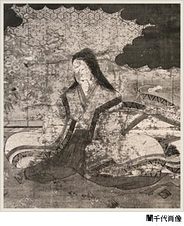 Tachibana Ginchiyo
Tachibana Ginchiyo During the Sengoku era there was a kokujin-class family known as the Ii who were located in Tōtōmi province. From this family came Ii Naomasa, one of the `four great teachers` of the Tokugawa shōgunate and the family that later became the provincial rulers of Ōmi province from Hakone during the Edo period. The family itself arose to kokujin status in the aftermath of the civil war that occurred during the Nanbokuchō period, and were located in Iinoya in Tōtōmi province. In the Sengoku era, the power of the Imagawa extended as far as Tōtōmi, hence the Ii family became bound to the Imagawa as one of their retainers.(212)
On the 19th day of the 5th month of Eiroku 3 (1560) at the Battle of Okehazama, the head of the Ii household, Ii Naomori, was part of the forces that made up the spear point of the Imagawa army, and was subsequently killed in the battle. Naomori had no male heirs, hence Naochika, the grandson of Naomori`s grandfather Naohira, succeeded as head of the household. (214) However, after the death of (Imagawa) Yoshimoto, the head of the Imagawa household, Ujizane, began to believe that Naochika was secretly corresponding with Matsudaira Motoyasu (later known as Tokugawa Ieyasu), and thus had Naochika killed.(214)
The death of Naochika plunged the Ii household into a succession crisis. Given the way that Naochika had died, there were fears that his son Manchiyo (later known as Naomasa)`s life was also in danger. Manchiyo was thus hidden away, and after consultations within part of the family, Naomori`s daughter was declared to be head of the household. The `Records of the Ii Household` (Ii Ke Denki) state that `Jirō Hōshi was a woman, and while ruling over the territory of the Ii household, would take on the priestly name of Jirō Hōshi, to which there were no objections`.(214)
The name `Jirō Hōshi` sounds like that of a man, but the reality was that this `he` was a `she`. It was the beginning of the concept of `female jitō`. According to related documents of the Ii household, there are items that bare the signature of `Jirō Hōshi` and a black seal of the same name. What this tells us is that `female jitō` Jirō Hōshi did actually rule over territory. While Imagawa Jukeini, a female daimyō, would sign documents using her own name, `female jitō` Jirō Hōshi continued to use a man`s name. (214).
Jirō Hōshi began by having documents stamped with a seal under this name, but eventually she took on the male name of `Jirō Naotora`, and changed her signature to the same effect. This was a highly unusual case of a woman taking on both a man`s name, and using a form of signature that was only used by adult males. (215) The fact that the daughter of Ii Naomori took on a man`s name and ruled over the Ii territory certainly went against the thinking of the age. After the role of women as a wife and mother became established as a concept, it was thought that that women had no right to carry on the household, although it wasn`t completely out of the question. Yet if we gather together some of the historical records of the time, there are quite a number of cases of women being given the responsibility of running a household.(215)
One example of this was Tachibana Dōsetsu, who handed over the affairs of his household to his daughter Ginchiyo. Tachibana Dōsetsu was originally known as Betsugi Akitsura, and was a retainer of the household of Ōtomo Sōrin and well known as a military strategist. Dōsetsu had no sons and only one daughter - Ginchiyo. On this point, Dōsetsu went to Sōrin and said `I wish for my daughter Ginchiyo to be allowed to take over my household, and I would like you to approve this`. Unfortunately the document that Dōsetsu used to make his request has not survived the ravages of time, but what we do know is that in a response signed by Sōrin and his son Yoshimune, the request was acknowledged and made known to all the other retainers of the Ōtomo household. (215)
Incidentally, this document was signed on the 18th day of the 6th month of Tenshō 3 (1575), which means that Ginchiyo was only 7 years old at the time it was signed. We do have to wonder whether Dōsetsu was in his right mind when he handed over the running of his household to young girl of seven. On this point we just do not know what he was thinking. In later year, however, Ginchiyo would become the wife of Tachibana Muneshige (a famous figure in the latter Sengoku era history of Kyushu). (216)
 RSS Feed
RSS Feed